Australia So Much to See
South Western Queensland - Bollon and St George
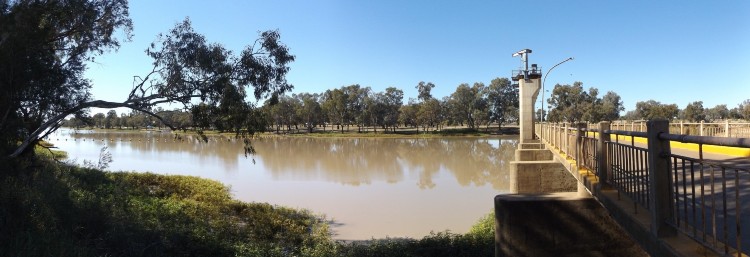
With the regional centre at St George, the Ballone Council encompasses the towns of St George, Ballon, Nindigully, Thallon, Mungindi,
Dirranbandi and Hebel, all of which we visit on this trip.
St George is on the banks of the Balonne River, which is dammed to form the Jack Taylor Weir at the Andrew Nixon Bridge (above). This dam enabled cotton growing to become a major industry in the St George area. The town has been subject to flooding from
the Ballone River, and in recent floods, much of the town was evacuated in March 2010 and in February 2012.
Scar tree and artefacts alongside Wallam Creek. Native trees were used to make canoes, coolamons and other useful items. Trees with bark removed indicate a semi-permanent dwelling area.
This small town with little over 300 people is loved by travellers for its free (donation) camping along Wallam Creek on the outskirts of town at a wide pool which is suitable for fishing. At the western end of town, turn north at Fire Brigade shed.
Rubbish bins are provided along the camping area, and there is a dump point with hose near the entrance. There is a toilet
at the cemetery at the far end of the campground which some campers have used. The donation box is out of the way at far end of campground.
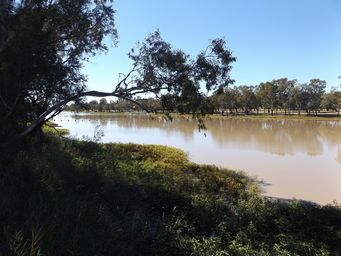
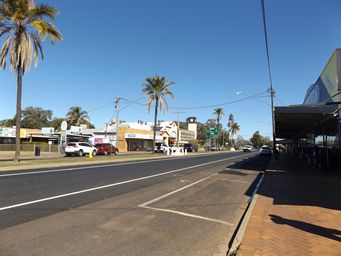
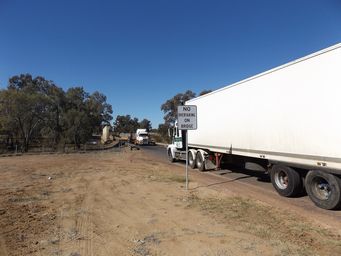
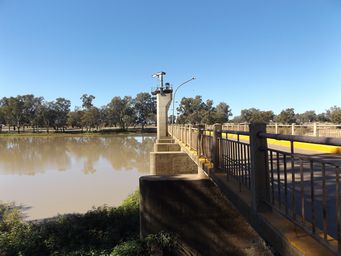
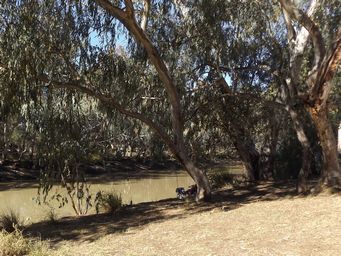
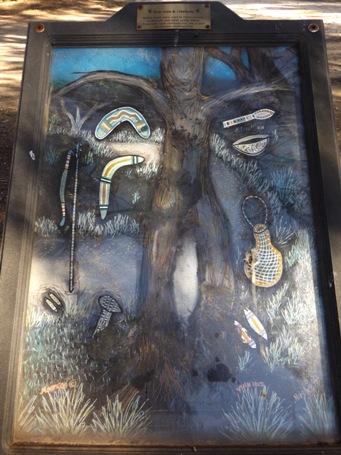
There is a formed walkway of one kilometre to toilets and showers in town towards the east end of the Main Street. Aboriginal
Dreamtime Artworks can be viewed along the walkway. There is also the exercise equipment along the way.
The town of Bollon was established in 1879 and is thought to be named after either the indigenous name for Wallam Creek or a type
of stone axe. While the town is signed as a natural koala habitat, we did not see any in the tees along Wallam Creek.
The town has a tiny historic Post Office, a pub, a café, and a mechanical services business, but little else in the way of shops
and services. Deb’s café has a historical shearing display, as sheep were once a major industry in the area.
There is
a council library, sporting venues and a showground.
A very small one-teacher primary school has its origins dating back
to 1885. Here the teaching principal is assisted by teaching aids and visiting subject specific teachers, plus access to distance
education for a broader education.
Visit the Bollon Heritage Centre in the main street, where Aboriginal and pastoral
history can be followed.
We entered St George from the west, at first crossing the Jack Taylor Weir/Andrew Nixon Bridge on the Balonne River. This forms
a single lane bridge. A truck can be seen at right giving way to a truck crossing the bridge.
Just downstream from the Maranoa River confluence and on the northern edge of St George, the E.J. Beardmore Dam is an earth-fill embankment
dam with a concrete gravity wall across the Balonne River. The resultant reservoir is called Lake Kajarabie.
Water from these
dams is used for irrigation for cotton, wheat, grapes, melons, peanuts and small crops. It is also the town water supply for
St George, including industrial water for abattoir use.
Approval to establish the St George Scheme granted in 1953 and was based
on a water supply from Jack Taylor Weir. The first new irrigation farms were opened in 1956 and the scheme was extended with the construction
of Beardmore Dam in 1967, which was completed five years later.
Street scene, St George (at right)
Sir Thomas Mitchell named the town St George. A plaque outside town explains: 'At this spot
on St Georges Day - April 23 1846 - Sir Thomas Mitchell crossed the Balonne and established a camp calling the crossing St Georges
Bridge.
Follow the Heritage Trail which will show you 31 heritage sites as on this brochure
See also the History of Cotton Mural. This mural was sponsored by the St George Cotton Growers Association in celebration of the 150th anniversary of the establishment of the town of St George. It depicts the history of the local cotton industry. A feature is the Jack Taylor weir which enabled the start of the St George cotton industry. Painted in 1996 by artist Kevin Taylor, this mural is 12 metres long and 2.85 metres high. Look for this mural in Balonne Street, at the junction of Victoria Street (Carnarvon Highway).
The first cotton gin in St George was built in 1974, with a second in 1999. Much of the
cotton grown in Queensland is grown in the St George and Dirranbandi areas, together with the Macintyre Valley, Goondiwindi.
Rural industries centre on dryland farming of sheep and cattle and cotton under irrigation.